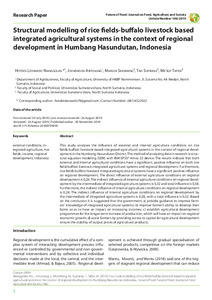| dc.date.accessioned | 2020-01-14T13:14:24Z | |
| dc.date.available | 2020-01-14T13:14:24Z | |
| dc.date.issued | 2019-11-30 | |
| dc.identifier | doi:10.17170/kobra-20190709595 | |
| dc.identifier.uri | http://hdl.handle.net/123456789/11421 | |
| dc.language.iso | eng | |
| dc.publisher | Section Specialized Partnerships in Sustainable Food Systems and Food Sovereignty at the University of Kassel, Germany and Federation of German Scientists (VDW) | |
| dc.rights | Urheberrechtlich geschützt | |
| dc.rights.uri | https://rightsstatements.org/page/InC/1.0/ | |
| dc.subject | external conditions | eng |
| dc.subject | integrated agriculture | eng |
| dc.subject | rice fields | eng |
| dc.subject | income | eng |
| dc.subject | regional development | eng |
| dc.subject | Indonesia | eng |
| dc.subject.ddc | 630 | |
| dc.title | Structural modelling of rice fields-buffalo livestock based integrated agricultural systems in the context of regional development in Humbang Hasundutan, Indonesia | eng |
| dc.type | Aufsatz | |
| dcterms.abstract | This study analyses the influence of external and internal agriculture conditions on rice fields-buffalo livestock-based integrated agricultural systems in the context of regional development in the Humbang Hasundutan District. The method of analyzing data in research is structural equation modeling (SEM) with IBM SPSS® Amos 22 device. The results indicate that both external and internal agricultural conditions have a significant, positive influence on both rice field-buffalo livestock integrated agricultural systems and regional development. Furthermore, rice fields-buffalo livestock integrated agricultural systems have a significant positive influence on regional development. The direct influence of external agriculture conditions on regional development is 0,26. The indirect influence of external agriculture conditions on regional development by the intermediate of integrated agriculture systems is 0,32 and total influence is 0,58. Furthermore, the indirect influence of internal agriculture conditions on regional development is 0,24. The indirect influence of internal agriculture conditions on regional development by the intermediate of integrated agriculture systems is 0,28, with a total influence is 0,52. Based on the conclusion it is suggested that the government; a) provide guidance to improve farmers' knowledge of integrated agricultural systems; b) improve farmers’ ability to develop their farms so as to have an impact on increasing incomes; c) establish agricultural development programmes for the longer-term increase of production, which will have an impact on regional economic growth; d) assist farmers by providing access to capital for agricultural development ensure the stability of output prices of agricultural products. | eng |
| dcterms.accessRights | open access | |
| dcterms.creator | Nainggolan, Hotden Leonardo | |
| dcterms.creator | Aritonang, Johndikson | |
| dcterms.creator | Sihombing, Marlon | |
| dcterms.creator | Supriana, Tavi | |
| dcterms.creator | Tafsin, Ma'ruf | |
| dc.type.version | publishedVersion | |
| dcterms.source.identifier | ISSN 2197-411X | |
| dcterms.source.issue | No 2 | |
| dcterms.source.journal | Future of Food: Journal on Food, Agriculture & Society | eng |
| dcterms.source.pageinfo | Article Number 106 | |
| dcterms.source.volume | Volume 7 | |

